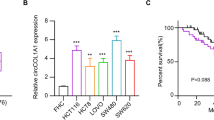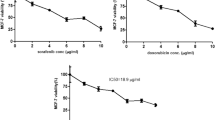Abstract
Cross-talk among inflammation and colorectal cancer cells is chiefly reported through a complex of cytokines, chemokines, and growth factors. MicroRNA performs strategic roles in controlling a variety of signaling cascades. miR-34a is known as a master regulator of tumor suppression. Combined application of different miRNA-based agents and chemotherapeutic drugs has been used to augment drug sensitivity and may reinforce the antitumor effect. A lot of studies specify a substantial increase in the effectiveness of combination therapies. The anti-inflammatory activity of Zerumbone (ZER) was investigated in many cancers. In this study the level of the inflammatory cytokines including CXCL-12 (SDF-1), CCL-2 (MCP-1), TGF-β and IL-33 has been measured in pmiR-34a-5p transfected and pmiR-34a-5p +ZER treated CRC cell lines (HCT-116 and SW48) by QRT-PCR and ELISA methods, respectively. The results showed that miR-34a could significantly inhibit cytokine expression in both cell lines for 48 and 72 h except SDF-1 which no inhibition was observed in SW48 cells. ZER suppressed SDF-1 for all three time points in both cell lines, while in SW48 cells IL-33 and TGF-β were inhibited in 72 h and in HCT-116 cells MCP-1 diminished for only 24 h and TGF-β diminished for all three times. Combination of both miR-34a and ZER suppressed TGF-β, SDF-1 and MCP-1 in HCT-116 cells in all time points while in SW48 cells, suppression of most cytokines was observed in 48 and 72 h. Furthermore Colony formation assay and scratch test were employed to detect changes of proliferation and migration in CRC transfected and treated cells. Generally, we found that miR-34a could considerably decrease the expression of inflammatory cytokines and the combination of ZER+ miR-34 boosted this effect. Moreover the migration and proliferation decreased in treated and transfected cells and this reduction was more severe in miR-34a +ZER treatment. It is important to note that in the case of cell resistance to each of these therapeutic agents, inhibition of cytokines can be compensated by another one.








Similar content being viewed by others
References
Slabáková E, Culig Z, Remšík J, Souček K (2017) Alternative mechanisms of miR-34a regulation in cancer. Cell Death Dis 8(10):e3100
Engkvist M, Stratford E, Lorenz S, Meza-Zepeda L, Myklebost O, Munthe E (2017) Analysis of the miR-34 family functions in breast cancer reveals annotation error of miR-34b. Sci Rep 7(1):9655
Zhang L, Liao Y, Tang L (2019) MicroRNA-34 family: a potential tumor suppressor and therapeutic candidate in cancer. J Exp Clin Cancer Res 38(1):53
Nie D, Fu J, Chen H, Cheng J, Fu J (2019) Roles of microRNA-34a in epithelial to mesenchymal transition, competing endogenous RNA sponging and its therapeutic potential. Int J Mol Sci 20(4):861
Zhu W, Long JL, Yin YT, Guo HN, Jiang EP, Li YL et al (2019) MicroRNA-34a suppresses the invasion and migration of colorectal cancer cells by enhancing EGR1 and inhibiting vimentin. Exp Ther Med 18(4):2459–2466
Landskron G, De la Fuente M, Thuwajit P, Thuwajit C, Hermoso MA (2014) Chronic inflammation and cytokines in the tumor microenvironment. J Immunol Res 2014:149185
Chen L, Deng H, Cui H, Fang J, Zuo Z, Deng J et al (2018) Inflammatory responses and inflammation-associated diseases in organs. Oncotarget 9(6):7204
Shrihari T (2017) Dual role of inflammatory mediators in cancer. Ecancermedicalscience 11:721
Zhang S, Yang X, Wang L, Zhang C (2018) Interplay between inflammatory tumor microenvironment and cancer stem cells. Oncol Lett 16(1):679–686
Qu X, Tang Y, Hua S (2018) Immunological approaches towards cancer and inflammation: a cross talk. Front Immunol 9:563
Jiang P, Liu R, Zheng Y, Liu X, Chang L, Xiong S et al (2012) MiR-34a inhibits lipopolysaccharide-induced inflammatory response through targeting Notch1 in murine macrophages. Exp Cell Res 318(10):1175–1184
Deshmane SL, Kremlev S, Amini S, Sawaya BE (2009) Monocyte chemoattractant protein-1 (MCP-1): an overview. J Interferon Cytokine Res 29(6):313–326
Yoshimura T (2018) The chemokine MCP-1 (CCL2) in the host interaction with cancer: a foe or ally? Cell Mol Immunol 15(4):335
Janssens R, Struyf S, Proost P (2018) The unique structural and functional features of CXCL12. Cell Mol Immunol 15(4):299–311
García-Cuesta EM, Santiago CA, Vallejo J, Juarranz Y, Rodriguez Frade JM, Mellado M (2019) The role of the CXCL12/CXCR4/ACKR3 axis in autoimmune diseases. Front Endocrinol 10:585
Chang HC, Huang PH, Syu FS, Hsieh CH, Chang SLY, Lu J et al (2018) Critical involvement of atypical chemokine receptor CXCR7 in allergic airway inflammation. Immunology 154(2):274–284
Chan BC, Lam CW, Tam L-S, Wong CK (2019) IL33: roles in allergic inflammation and therapeutic perspectives. Front Immunol 10:364
Miller AM (2011) Role of IL-33 in inflammation and disease. J Inflamm 8(1):22
Biancheri P, Giuffrida P, Docena GH, MacDonald TT, Corazza GR, Di Sabatino A (2014) The role of transforming growth factor (TGF)-β in modulating the immune response and fibrogenesis in the gut. Cytokine Growth Factor Rev 25(1):45–55
Hao Y, Baker D, ten Dijke P (2019) TGF-β-mediated epithelial-mesenchymal transition and cancer metastasis. Int J Mol Sci 20(11):2767
Kalantari K, Moniri M, Boroumand Moghaddam A, Abdul Rahim R, Bin Ariff A, Izadiyan Z et al (2017) A review of the biomedical applications of zerumbone and the techniques for its extraction from ginger rhizomes. Molecules 22(10):1645
Murakami A, Miyamoto M, Ohigashi H (2004) Zerumbone, an anti-inflammatory phytochemical, induces expression of proinflammatory cytokine genes in human colon adenocarcinoma cell lines. BioFactors 21(1–4):95–101
Girisa S, Shabnam B, Monisha J, Fan L, Halim CE, Arfuso F et al (2019) Potential of zerumbone as an anti-cancer agent. Molecules 24(4):734
Hosseini N, Khoshnazar A, Saidijam M, Azizi Jalilian F, Najafi R, Mahdavinezhad A et al (2019) Zerumbone suppresses human colorectal cancer invasion and metastasis via modulation of FAk/PI3k/NFκB-uPA pathway. Nutr Cancer 71(1):159–171
Janakiram NB, Rao CV (2014) The role of inflammation in colon cancer. Inflamm Cancer 816:25–52
Cooper K, Squires H, Carroll C, Papaioannou D, Booth A, Logan R et al (2010) Chemoprevention of colorectal cancer: systematic review and economic evaluation. NIHR J Library 27(2):114–122
Kraus S, Arber N (2009) Inflammation and colorectal cancer. Curr Opin Pharmacol 9(4):405–410
Klampfer L (2011) Cytokines, inflammation and colon cancer. Curr Cancer Drug Targets 11(4):451–464
Yob N, Jofrry SM, Affandi M, Teh L, Salleh M, Zakaria Z (2011) Zingiber zerumbet (L.) Smith: a review of its ethnomedicinal, chemical, and pharmacological uses. Evid Based Complement Altern Med 2011:543216
Ozaki Y, Kawahara N, Harada M (1991) Anti-inflammatory effect of Zingiber cassumunar Roxb. and its active principles. Chem Pharm Bull 39(9):2353–2356
Misso G, Di Martino MT, De Rosa G, Farooqi AA, Lombardi A, Campani V et al (2014) Mir-34: a new weapon against cancer? Mol Therapy Nucleic Acids 3:e195
Qiao P, Li G, Bi W, Yang L, Yao L, Wu D (2015) microRNA-34a inhibits epithelial mesenchymal transition in human cholangiocarcinoma by targeting Smad4 through transforming growth factor-beta/Smad pathway. BMC Cancer 15(1):469
Kurowska-Stolarska M, Ballantine L, Stolarski B, Hunter J, Hueber A, Gracie J et al (2010) miR-155 and miR-34a regulate proinflammatory cytokine production by human monocytes. Ann Rheum Dis 69(Suppl 2):A30
Tsuboi K, Matsuo Y, Shamoto T, Shibata T, Koide S, Morimoto M et al (2014) Zerumbone inhibits tumor angiogenesis via NF-κB in gastric cancer. Oncol Rep 31(1):57–64
Huang G, Du M-Y, Zhu H, Zhang N, Lu Z-W, Qian L-X et al (2018) MiRNA-34a reversed TGF-β-induced epithelial-mesenchymal transition via suppression of SMAD4 in NPC cells. Biomed Pharmacotherapy 106:217–224
Ma Z-L, Hou P-P, Li Y-L, Wang D-T, Yuan T-W, Wei J-L et al (2015) MicroRNA-34a inhibits the proliferation and promotes the apoptosis of non-small cell lung cancer H1299 cell line by targeting TGFβR2. Tumor Biol 36(4):2481–2490
Kim S, Lee J, Jeon M, Lee JE, Nam SJ (2016) Zerumbone suppresses the motility and tumorigenecity of triple negative breast cancer cells via the inhibition of TGF-β1 signaling pathway. Oncotarget 7(2):1544–1558
Hseu Y-C, Huang Y-C, Korivi M, Wu J-J, Way T-D, Ou T-T et al (2015) Zerumbone attenuates TGF-β1-mediated epithelial–mesenchymal transition via upregulated E-cadherin expression and downregulated Smad2 signalling pathways in non-small cell lung cancer (A549) cells. J Funct Foods 18:58–72
Kawano S, Nakamachi Y (2011) miR-124a as a key regulator of proliferation and MCP-1 secretion in synoviocytes from patients with rheumatoid arthritis. Ann Rheum Dis 70(Suppl 1):i88–i91
사현김, 시현김, 성률유, 평재이, 철문. Inhibitory effects of zerumbone on MCP-1-induced THP-1 migration. Korean J Clin Lab Sci 2018;50(2):177–82.
Li Z, Li N, Wu M, Li X, Luo Z, Wang X (2013) Expression of miR-126 suppresses migration and invasion of colon cancer cells by targeting CXCR4. Mol Cell Biochem 381(1–2):233–242
Sung B, Jhurani S, Ahn KS, Mastuo Y, Yi T, Guha S et al (2008) Zerumbone down-regulates chemokine receptor CXCR4 expression leading to inhibition of CXCL12-induced invasion of breast and pancreatic tumor cells. Can Res 68(21):8938–8944
Dubois-Camacho K, Diaz-Jimenez D, De La Fuente MK, Quera RE, Simian D, Martínez M et al (2019) Inhibition of miR-378a-3p by inflammation enhances IL-33 levels: a novel mechanism of alarmin modulation in ulcerative colitis. Front Immunol 10:2449
Hou C, Wang D, Zhang L (2019) MicroRNA-34a-3p inhibits proliferation of rheumatoid arthritis fibroblast-like synoviocytes. Mol Med Rep 20(3):2563–2570
Zhao J, Bader AG (2017) Evaluating synergistic effects of miR-34a mimics in combination with other therapeutic agents in cultured non-small cell lung cancer cells. Drug Target miRNA 1517:115–126
Zhao J, Kelnar K, Bader AG (2014) In-depth analysis shows synergy between erlotinib and miR-34a. PLoS ONE 9(2):e89105
Zhu M, Zheng Z, Huang J, Ma X, Huang C, Wu R et al (2019) Modulation of miR-34a in curcumin-induced antiproliferation of prostate cancer cells. J Cell Biochem 120(9):15616–15624
Sun C, Zhang S, Liu C, Liu X (2019) Curcumin promoted miR-34a expression and suppressed proliferation of gastric cancer cells. Cancer Biotherapy Radiopharm 34(10):634–641
Funding
This study was supported by a grant from Hamadan University of Medical Sciences (9511267103).
Author information
Authors and Affiliations
Corresponding author
Ethics declarations
Conflict of interest
The authors declare that there is no conflict of interests.
Ethical approval
This article does not contain any studies with human participants performed by any of the authors.
Informed consent
For this type of study formal consent is not required.
Additional information
Publisher's Note
Springer Nature remains neutral with regard to jurisdictional claims in published maps and institutional affiliations.
Rights and permissions
About this article
Cite this article
Dehghan, R., Najafi, R., Azizi Jalilian, F. et al. A promising effect of zerumbone with improved anti-tumor-promoting inflammation activity of miR-34a in colorectal cancer cell lines. Mol Biol Rep 48, 203–218 (2021). https://doi.org/10.1007/s11033-020-06035-9
Received:
Accepted:
Published:
Issue Date:
DOI: https://doi.org/10.1007/s11033-020-06035-9




